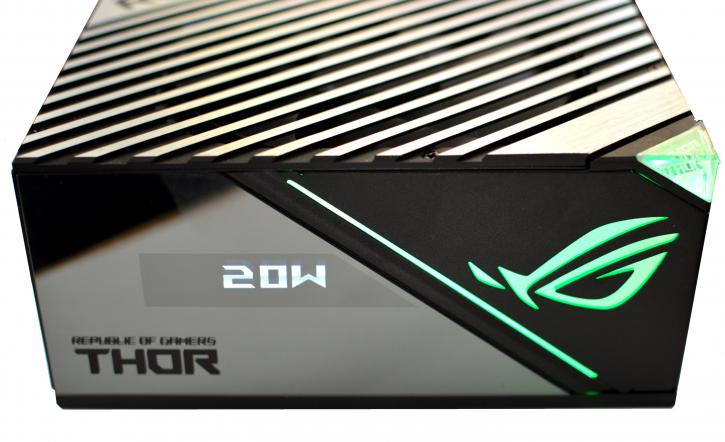Final Words & Conclusion
Final Words & Conclusion
The Asus ROG THOR 1000W PLATINUM II is a terrific product. The platform for this ATX power supply unit has been taken from Seasonic (Prime Ultra Platinum). The size is not compact (190 mm in length), so you’ll rather need a bigger chassis to make it fit without a problem. You can find the fanless mode here, which you can disable, and it would still be a quiet power supply unit (with 400-450 rpm). The exterior looks great, but the thing is that most of the chassis nowadays have a PSU shroud, which would hide this piece of art behind a metal. There are two Asus selling points - an OLED display (that allows to show the power consumption of a system) and the ARGB lighting, but this without an appropriate chassis will also stay hidden, which is a pity. It would be better to have the possibility to rotate the display layout or have it possible to show the power consumption in some software (Asus Armoury Crate?) so that the user would be aware of the values. The unit comes with a 10-year warranty, but the display and the lighting are covered by three years. It’s an 80 Plus Platinum certified PSU, and that’s a typical choice for even the high-end systems (maybe a bit more) from the consumer’s point of view (in terms of efficiency/price of the unit). The 1000 W variant offers a massive power output that should be enough for most users, even the most elaborate gaming setups with a single graphics card in their system. In reality, even a PC like the one used in this test (i9 12900K + Geforce RTX 3080) rarely exceeds 500-550 W of power draw. On the quality side, all is great, and the stability tests also went well. Load regulation is excellent, and there was no noticeable droop on the +5V and +12V rails. Ripple suppression is safely within tolerance. The 135 mm fan (from Champion ) does its job very well when it’s supposed to spin. It becomes audible close to 85-90% load, so there’s no reason for complaining. You get a lovely set of accessories in the package, including mounting screws, a power cord, a manual (so a rather typical set), but also there are velcro straps. The provided cables come in a solid and flexible braided casing to neatly and beautifully place inside the PC case. There’s a 12-pin Gen 5 PCIe compatible cable, still – it’s a pity it’s not the 16-pin, which would support even 600 W GPU power draw (here it’s 450).
A word about efficiency
Same as with any other power supply, 50% of the maximum load is where the device is most efficient. The sweet spot of the Asus ROG THOR 1000W PLATINUM II is a bit over 94% (at 230 Volts). In the case of this particular unit, half of the maximum wattage is 500 W. The average gaming PC with a single graphics card (at least those usually spotted in Steam hardware polls) won’t exceed this value under normal conditions. Don’t overestimate the savings (on your electricity bill) that you can make by going from 80 Plus Bronze to even Titanium. You can assume that the build quality of more expensive PSUs will be higher, but the differences in efficiency are not that significant. So, summing it up, an 80 Plus Platinum PSU like the Asus ROG THOR 1000W PLATINUM II is a great solution. The price is about 360 EUR for the 1000 W variant, which is expensive, even for a high-wattage PSU.
Stability
There isn’t much to say about stability. The voltages hold, and this doesn’t change under higher loads. The 1000 W version should be enough for dual-GPU setups with cards like an Nvidia Geforce GTX/RTX 1080/2080 (or even a dual RTX 3070Ti/3080) or a single GPU like an RTX 3080(Ti)/3090.
Aesthetics
This Asus PSU looks nice with its all-black cabling. The Asus Thor II approach with modular cables lets you plug in only the leads you need, improving your build’s looks. All connectors are individually sleeved cables except the SATA and Molex cables (typical flat ribbon-style). Additionally, this makes the installation process is quite simple. The OLED display and the ARGB lighting make it stand out from the crowd, but you need to remember that the chassis will need to allow you to show it. The case of THOR II looks excellent; the finishing of this product makes it look very premium. Still, the PSU shroud that you’ll usually have or the compartment for the power supply at the back of the motherboard tray wouldn’t help. Not so many chassis (besides ASUS ROG Helios) will allow the appropriate presentation. Even when you have it, the fan of the reviewed product will need to be faced upwards (when usually the filters are at the bottom of the chassis), which is not the best solution.
Final words
The ROG THOR 1000W PLATINUM II retails at 360 EUR, a steep price, but you need to remember that it’s a premium-level product designed for overclocking and gaming enthusiasts. The unit looks great – you can see that it was one of the focus points of Asus; the finishing is high-quality/design, the ARGB lighting is also an excellent addition, there is also an OLED display to show energy consumption. Speaking of which, it’s a pity that you won’t even see the unit in most of the chassis, as it would be hidden behind the PSU shroud or at the back of the motherboard tray, so in most cases, that effort wasn’t so much needed. Maybe in Thor III, Asus should enable the possibility to rotate the display, or at least allow the option to show the power consumption in the software? As for the power delivery itself – there’s no reason to be worried, Seasonic has made the platform, and it’s a customized Prime Ultra Platinum, and the results are fantastic. The ROG THOR 1000W PLATINUM II offers excellent acoustics (as it becomes audible only above 85-90% load) and great build quality. According to the standards, the efficiency is like it should be for the 80 Plus Platinum award. You also get a 10-year warranty, which you would expect in that price range, but the OLED screen and the ARGB lighting have 3 (why?). You also get the 12-pin PCIe 5.0 compatible cable for powering up to 450 W GPUs (it’s a pity it’s not a 16-pin with 600 W support like in the Loki series). The package is excellent; this product ticks all the essential boxes (and even more). It’s a great option not only for the hardcore Asus fans, but you need to dig deep in your pocket, and that’s the biggest drawback. Still - thanks to its outstanding performance, it stands out in the market. It’s applicable, especially for the noise (or lack of it in most scenarios), but not only. The aesthetics are also great (but in most cases, you won’t have the possibility to see it – hopefully Asus will address this). We think that this PSU deserves our “Top Pick” award, but also understand it's not for everyone due to the pricing.
- Sign up to receive a notification when we publish a new article
- Or go back to Guru3D's front page



